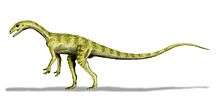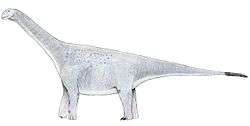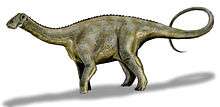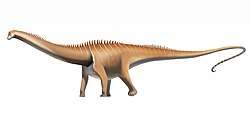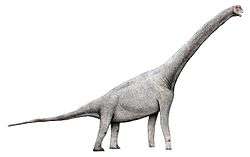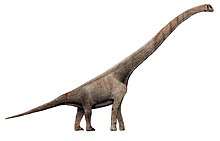Diplodocinae
Diplodocinae is an extinct subfamily of diplodocid sauropods that existed from the Late Jurassic to Early Cretaceous of North America, Europe and South America, about 161.2 to 136.4 million years ago. Genera within the subfamily include Tornieria, Supersaurus, Leinkupal, Galeamopus, Diplodocus, Kaatedocus[2] and Barosaurus.[1]
| Diplodocines | |
|---|---|
 | |
| Skeleton of Galeamopus | |
| Scientific classification | |
| Kingdom: | Animalia |
| Phylum: | Chordata |
| Clade: | Dinosauria |
| Clade: | Saurischia |
| Suborder: | †Sauropodomorpha |
| Clade: | †Sauropoda |
| Family: | †Diplodocidae |
| Subfamily: | †Diplodocinae Janensch, 1929 |
| Genera[1] | |
Cladogram of the Diplodocidae after Tschopp, Mateus, and Benson (2015).[1]
| Diplodocidae |
| ||||||||||||||||||||||||||||||||||||||||||||||||||||||||||||||||||
References
- Tschopp, E.; Mateus, O. V.; Benson, R. B. J. (2015). "A specimen-level phylogenetic analysis and taxonomic revision of Diplodocidae (Dinosauria, Sauropoda)". PeerJ. 3: e857. doi:10.7717/peerj.857. PMC 4393826. PMID 25870766.
- E Tschopp, O Mateus 2013 The skull and neck of a new flagellicaudatan sauropod from the Morrison Formation and its implication for the evolution and ontogeny of diplodocid dinosaurs. Journal of Systematic Palaeontology 11 (7), 853-888
This article is issued from Wikipedia. The text is licensed under Creative Commons - Attribution - Sharealike. Additional terms may apply for the media files.
